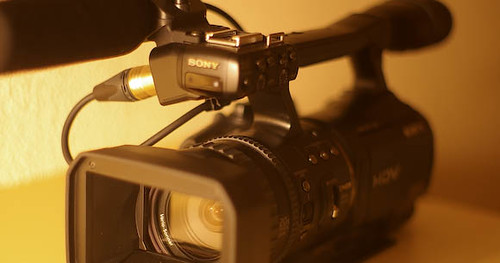After asking CDMo readers for advice and promising various parties that I’d never buy another Sony product, I walked into my local VideoPro with a definite plan of attack: Compare and contrast the Canon XH-A1 and Panasonic HVX-200, and then buy one of them.
What followed is still a little hazy in my mind, but it seems there was a sales guy who actually knew his stuff, listened to my requirements and was able to suggest an alternative which was not only better suited to my needs, but also considerably cheaper. That this alternative was a Sony – a brand I’d sworn never to purchase again – just adds to the confusion. I’m still trying to figure out what happened.
The XH-A1 and HVX-200 are both great cameras, they look good, feel good, and by most accounts shoot exceptional video, generally on par with each other’s performance. Why, then, did I walk out of there with an HVR-V1P?:
- Physically smaller and lighter
- 200FPS “Smooth Slow Record” slow motion mode
- Uncompressed HDMI output
- Good quality Sony shotgun mic included
- External battery bay (as opposed to the XH-A1’s internal one) which is compatible with Sony’s NP-F range, including the batteries I still have from my 10 year old DCR-TRV9.
- AU$1500-3000 cheaper than the Canon and Panasonic offerings
I haven’t had the time to really get to know this camera, but initial impressions are very positive.
Smooth Slow Record records to HDV1080i format, but the effective resolution is greatly decreased. This is fantastic for motion tracking and will look great for web video, or at medium resolution for VJing (although it can’t be used for live visuals, as the camera has to buffer the video information and then write to tape), but definitely won’t cut it if mixed directly in with HD video or for delivery to TV or DVD. The system will only record slow motion in 3, 6 or 12 second bursts, but this is quite reasonable as 12 seconds recorded at 200FPS takes up 96 seconds when played back at 25FPS.
Those limitations aside, I am absolutely addicted to Smooth Slow Record. Mundane things suddenly become magical when viewed at this speed. I’m sure the infatuation will wear off eventually, but a week after picking up the camera I’ve hardly shot any real HD video at all, and my biggest wish is that I could assign one of the camera’s 6 user-definable buttons to SSR, rather than fiddling through menus to activate it.
At the other end of the quality spectrum, an HDMI port allows output of an uncompressed 4:2:2 signal, which could be used for tethered shooting of high quality green screen material, or mixed live using Vade’s technique with the Decklink Intensity. To get uncompressed output on the Canon you need to step up to the XH-G1, a $3000 price increase which just adds a couple of extra output and timecode options.
To be fair, I don’t currently have the hardware to utilize HDMI – I don’t even have a digital TV – but I intend to keep this camera for at least a couple of years (I’ll be paying it off for 2), by which time I hope to be performing with HD projectors and mixers, so this is a nice bit of futureproofing.
The look of the unit is very professional. Most of the body is black anodized metal (aluminium?), the lens is nice and chunky, and framed by a removable lens hood which also contains a lever-operated shutter, a definite improvement over the traditional lens-cap-on-a-string. Everyone I’ve shown it to so far has immediately said “Ooooooooh”, which I take to be pretty positive feedback in the looks department.
Over the next couple of weeks on tour I’ll be spending plenty of time with this cam, so there should be a full review from the perspective of a visualist coming soon.
Oh, and plenty of slow-mo footage.
Updated: Sony HVR-V1P HDV Camera: Smooth Slow Motion Test and Slow Motion Resolution Test



